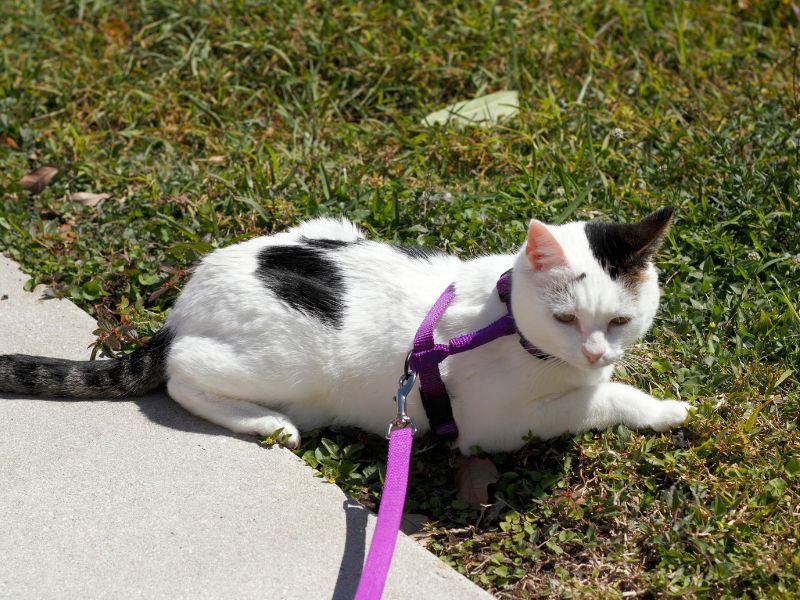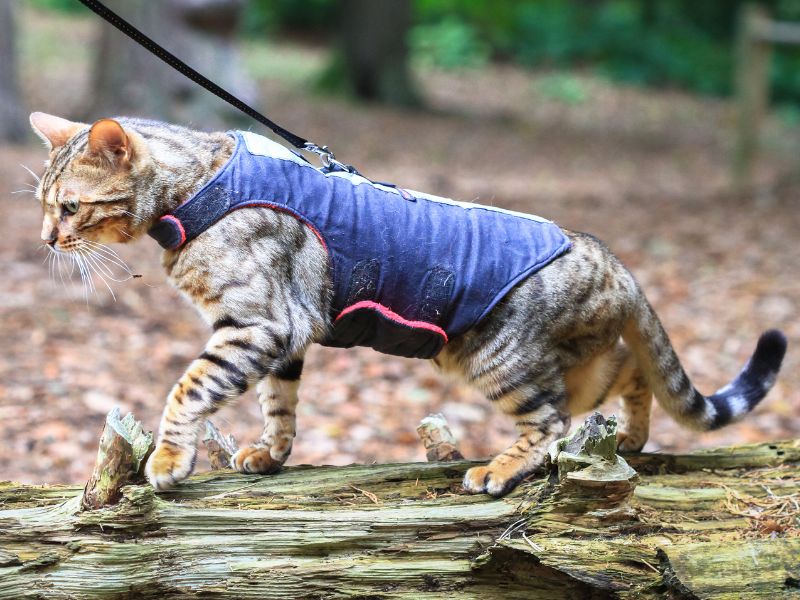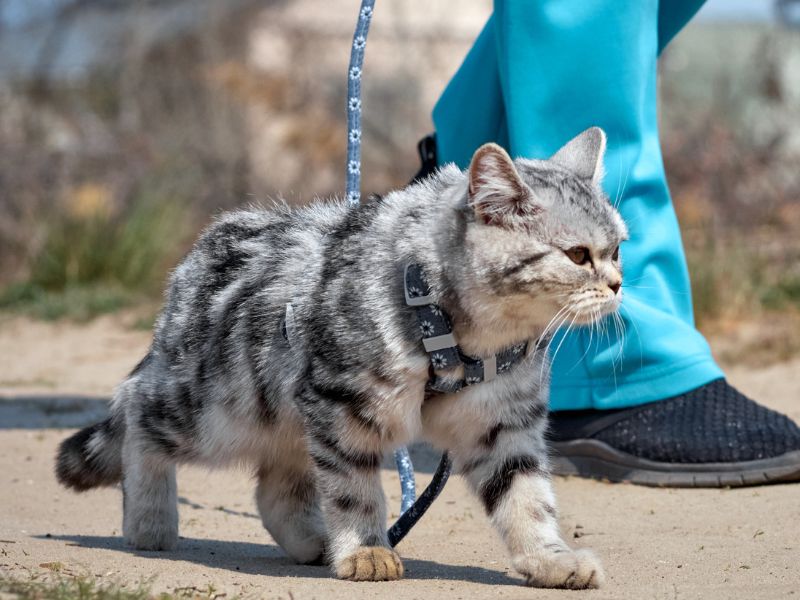Curiosity may have killed the cat, but in this case, it’s time to unleash the feline’s adventurous side. We all know that dogs are notorious for their love of going on walks, but what about our furry friends with whiskers? Can you really take a cat for a stroll on a lead? The answer might surprise you. While it may seem like an unusual concept, walking a cat on a lead is indeed possible, and it can provide a whole new world of exploration for your feline companion. But before you grab a leash and head out the door, there are a few things you need to know. In this article, we’ll dive into the world of cat walking and explore the benefits, challenges, and tips for successfully taking your cat on a lead. So, if you’re ready to embark on a unique adventure with your four-legged friend, let’s unravel the secrets of walking a cat on a lead.
Understanding a Cat’s Natural Instincts and Behavior
Cats are known for their independent nature and love of exploration. They are born hunters and have a strong instinct to roam and investigate their surroundings. Understanding a cat’s natural instincts and behavior is crucial when it comes to walking them on a lead.
Cats have a highly developed sense of territory, and they mark their territory by rubbing their scent on objects. This behavior is known as scent marking and is an important part of their communication with other cats. When walking a cat on a lead, it’s essential to respect their need for territory and allow them to explore at their own pace.
Another important aspect of a cat’s behavior is their prey drive. Cats are natural hunters, and they have an instinctual desire to chase and pounce on moving objects. This is why it’s important to choose a safe and secure location for your cat’s outdoor adventures, away from busy roads or other potential dangers.
To ensure a successful cat walking experience, it’s essential to understand and respect your cat’s natural instincts and behavior. By doing so, you can create a positive and enriching outdoor experience for both you and your feline friend.
The Benefits of Walking a Cat on a Lead
Walking a cat on a lead offers numerous benefits for both the cat and the owner. Let’s explore some of the advantages that come with taking your cat for a stroll.
- Physical Exercise: Cats need regular exercise to maintain a healthy weight and prevent obesity-related health issues. Walking on a lead provides an opportunity for your cat to burn off excess energy and stay fit.
- Mental Stimulation: Outdoor exploration is mentally stimulating for cats. It allows them to engage their senses, experience new sights and smells, and satisfy their curiosity. This mental stimulation can help prevent boredom and behavior problems in cats.
- Bonding Time: Walking a cat on a lead can be a great bonding experience for you and your feline friend. It provides an opportunity for quality one-on-one time and strengthens the bond between you.
- Environmental Enrichment: Cats are natural explorers, and walking on a lead allows them to experience the world outside their usual indoor environment. This exposure to new stimuli can enrich their lives and prevent boredom.
- Training and Control: Walking a cat on a lead can help teach them to follow commands and stay close to you. This training can be beneficial in situations where you need to keep your cat safe or control their behavior.
By walking your cat on a lead, you can provide them with physical exercise, mental stimulation, bonding time, environmental enrichment, and training and control. It’s a win-win situation for both you and your furry friend.

Preparing Your Cat for Leash Training
Before you can start walking your cat on a lead, it’s important to prepare them for leash training. Here are some steps to follow to ensure a smooth transition to outdoor adventures:
- Get Your Cat Used to a Harness: Most cats are not accustomed to wearing a harness, so it’s essential to introduce it gradually. Start by letting your cat sniff and explore the harness. Then, try putting it on for short periods of time, gradually increasing the duration as your cat becomes more comfortable.
- Associate the Harness with Positive Experiences: Make the harness a positive association for your cat by offering treats or playtime while they are wearing it. This will help them associate the harness with something enjoyable and reduce any anxiety or resistance.
- Practice Indoors: Once your cat is comfortable wearing the harness, start practicing indoors. Attach the leash to the harness and let your cat explore the house while supervised. This will help them get used to the sensation of being on a lead.
Remember, every cat is unique, and the time it takes for them to adjust to the harness and leash will vary. Be patient and allow your cat to progress at their own pace. Once they are comfortable indoors, you can move on to outdoor adventures.
Choosing the Right Leash and Harness for Your Cat
Choosing the right leash and harness is essential for the comfort and safety of your cat. Here are some factors to consider when selecting these items:
- Size and Fit: Ensure that the harness fits snugly but comfortably around your cat’s body. It should not be too tight or too loose. Measure your cat’s chest and neck circumference to find the right size.
- Material: Look for a harness made from a soft and durable material that won’t chafe or irritate your cat’s skin. Avoid harnesses with rough edges or excessive buckles that might cause discomfort.
- Leash Length: Opt for a leash that is long enough to give your cat some freedom to explore but short enough to maintain control. A leash length of 6-8 feet is usually sufficient.
- Safety Features: Choose a harness and leash with safety features, such as reflective strips or a breakaway mechanism. These features can help ensure your cat’s safety during outdoor adventures.
It’s important to invest in a high-quality harness and leash that are specifically designed for cats. Avoid using dog harnesses or retractable leashes, as they may not provide the right level of comfort and control for your feline friend.
Introducing Your Cat to the Leash and Harness
Now that you have the right leash and harness, it’s time to introduce them to your cat. Here’s a step-by-step guide to help you with the introduction process:
- Start Indoors: Begin by allowing your cat to explore the harness and leash indoors. Let them sniff and investigate the new items at their own pace. Offer treats and praise to create positive associations.
- Attach the Harness: Once your cat is comfortable with the harness, gently attach it to their body. Make sure it is properly adjusted and secure.
- Let Your Cat Drag the Leash: Allow your cat to drag the leash around the house while supervised. This will help them get used to the sensation of being connected to the leash.
- Practice Walking Indoors: With the leash in hand, encourage your cat to take a few steps with you indoors. Use treats and praise as rewards for positive behavior.
- Gradually Move Outdoors: Once your cat is comfortable walking indoors, you can start taking them outdoors. Begin with short walks in a quiet and secure area, gradually increasing the duration and distance.
Remember to be patient and positive throughout the training process. Offer plenty of rewards and encouragement to motivate your cat. With time and consistency, your cat will become more comfortable and confident on the leash.

Training Your Cat to Walk on a Lead
Training your cat to walk on a lead requires patience, consistency, and positive reinforcement. Here are some tips to help you with the training process:
- Take Small Steps: Start by walking short distances, and gradually increase the duration and distance of your walks as your cat becomes more comfortable. Allow your cat to set the pace and follow their lead.
- Use Positive Reinforcement: Reward your cat with treats, praise, and playtime for walking calmly on the lead. Positive reinforcement will encourage your cat to repeat the desired behavior.
- Keep Training Sessions Short: Cats have short attention spans, so keep your training sessions brief and engaging. Aim for multiple short sessions throughout the day rather than one long session.
- Be Patient: Cats learn at their own pace, so it’s important to be patient and not rush the training process. Celebrate small victories and give your cat time to adjust and build confidence.
- Avoid Punishment: Punishment or negative reinforcement can be counterproductive and may cause your cat to become fearful or resistant. Focus on positive reinforcement and ignore any unwanted behaviors.
By using positive reinforcement and being patient and consistent, you can train your cat to walk on a lead and enjoy outdoor adventures together. Remember, the goal is to create a positive and enjoyable experience for both you and your cat.
Tips for a Successful Cat Walking Experience
Walking a cat on a lead can be a unique and rewarding experience, but it’s important to keep a few tips in mind to ensure a successful outing:
- Choose the Right Time: Cats are crepuscular animals, meaning they are most active during dawn and dusk. Try to schedule your walks during these times to align with your cat’s natural activity patterns.
- Start with Familiar Territory: Begin your walks in an area that is familiar to your cat, such as your backyard or a quiet neighborhood street. This will help them feel more comfortable and secure.
- Bring Treats and Toys: Use treats and toys as rewards and distractions during your walks. This will help keep your cat engaged and focused on the positive aspects of the experience.
- Be Mindful of Environmental Factors: Keep an eye out for potential hazards during your walks, such as toxic plants, busy roads, or aggressive dogs. Ensure that your cat’s outdoor environment is safe and secure.
- Monitor Your Cat’s Behavior: Pay attention to your cat’s body language and behavior during the walk. If they show signs of stress or discomfort, such as freezing, crouching, or excessive pulling on the leash, it’s time to end the walk and try again another day.
Remember, every cat is different, and some may take longer to adjust to walking on a lead than others. Be patient and attentive to your cat’s needs and comfort level. With time and practice, you and your feline friend can enjoy many happy walks together.
Common Challenges and How to Overcome Them
Walking a cat on a lead is not without its challenges. Here are some common obstacles you may encounter and tips on how to overcome them:
- Resistance to the Harness: If your cat resists wearing the harness, try using positive reinforcement to create a positive association. Offer treats and praise whenever the harness is present, and gradually increase the time they wear it.
- Leash Pulling: Some cats may try to pull or tug on the leash during walks. To discourage this behavior, stop walking and wait until your cat relaxes the tension on the leash. Reward them with treats and praise when they walk calmly by your side.
- Distractions and Fear: Cats can be easily distracted or frightened by unfamiliar sights and sounds during walks. If your cat becomes anxious or scared, try to create distance from the triggering stimuli or redirect their attention with treats or toys.
- Overstimulation: Outdoor environments can be overwhelming for some cats, leading to overstimulation. If your cat becomes overexcited or agitated, take a break in a quiet area or shorten the duration of your walks.
- Lack of Interest: Not all cats will take to walking on a lead, and some may simply not enjoy the experience. Respect your cat’s preferences and don’t force them to walk if they show no interest. There are alternative ways to provide mental and physical stimulation for your cat.
Remember, patience and persistence are key when overcoming challenges. If you encounter difficulties, don’t give up. Adjust your approach, seek advice from professionals, and adapt to your cat’s individual needs.

See Also: How to Make Your Own Cat Toys with Household Items
And: Why Is My Cat Grooming Excessively?
Safety Precautions for Walking a Cat on a Lead
Ensuring the safety of your cat is paramount when walking them on a lead. Here are some safety precautions to keep in mind:
- Use a Secure Harness and Leash: Ensure that the harness and leash are secure and properly fitted. Regularly check for any signs of wear and tear and replace them as needed.
- Avoid Busy Roads and Dangerous Areas: Choose walking routes that are away from busy roads, unfamiliar territories, or areas with potential hazards. Stick to quiet neighborhoods or designated walking trails.
- Monitor the Temperature: Cats are sensitive to extreme temperatures, so avoid walking during the hottest part of the day or in extreme cold. Be mindful of your cat’s comfort and well-being during walks.
- Protect Against Fleas and Ticks: Outdoor environments can harbor fleas and ticks, so make sure your cat is protected with appropriate preventive measures. Consult with your veterinarian for the best options.
- ID and Microchip: Ensure that your cat is wearing a collar with identification tags and is microchipped. In case of any unforeseen incidents, these measures can help reunite you with your cat.
By following these safety precautions, you can minimize the risks and ensure a safe and enjoyable walking experience for both you and your cat.
Alternatives to Walking a Cat on a Lead
While walking a cat on a lead can be a great way to provide exercise and stimulation, it may not be suitable for every cat. If your cat shows no interest in walking on a lead or finds the experience stressful, there are alternative ways to enrich their lives:
- Indoor Play: Engage your cat in interactive play sessions using toys or laser pointers. This will provide mental and physical stimulation without the need for outdoor walks.
- Window Views: Create a stimulating environment for your cat by setting up perches or window shelves near windows. This will allow them to observe the outside world and engage with nature from the comfort of your home.
- Cat Enclosures: Consider setting up a cat enclosure or a catio in your backyard. This will provide a safe and controlled outdoor space for your cat to explore and enjoy fresh air.
- Training and Enrichment: Teach your cat new tricks or provide them with puzzle toys and interactive feeders to keep their minds sharp and engaged.
Remember, every cat is unique, and it’s important to find activities that suit their individual needs and preferences. Whether it’s walking on a lead or alternative forms of exercise, if your cat enjoys the experience, it will enrich its life, keep it physically fit, and improve the bonding between cat and owner.

